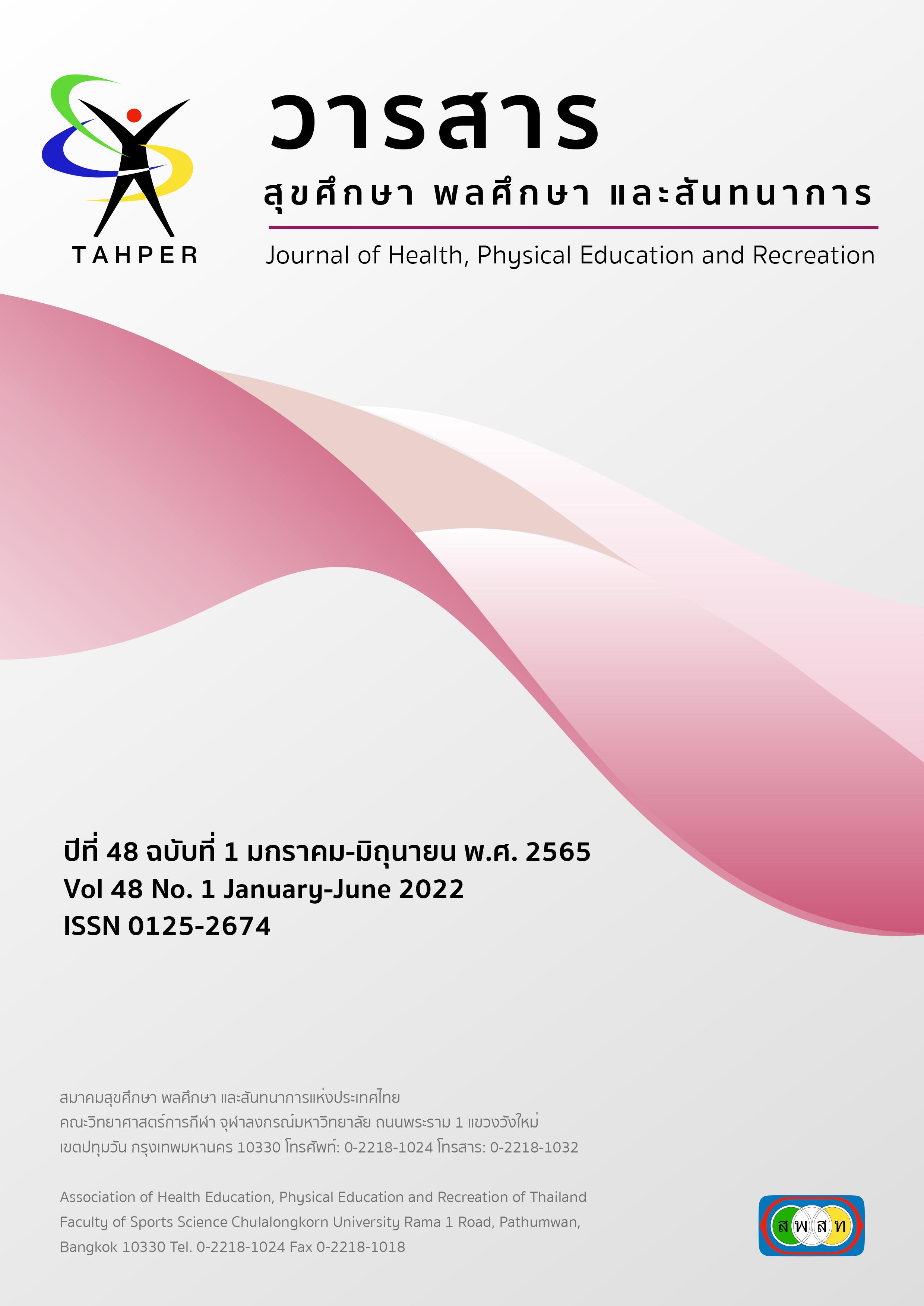ผลของการฝึกแบบหนักสลับเบาด้วยรูปแบบการวิ่งหลายทิศทางที่มีต่อสมรรถภาพการใช้ออกซิเจนและสมรรถภาพแบบไม่ใช้ออกซิเจน ในนักกีฬาแบดมินตันรุ่นเยาวชน Effect of Multi-Direction Interval Training Program on Aerobic Fitness and Anaerobic Fitness in Youth Badminton Players
Main Article Content
Abstract
บทคัดย่อ
การวิจัยในครั้งนี้มีวัตถุประสงค์ เพื่อศึกษาผลของการฝึกแบบหนักสลับเบาด้วยรูปแบบการวิ่ง หลายทิศทางที่มีผลต่อสมรรถภาพการใช้ออกซิเจนและสมรรถภาพแบบไม่ใช้ออกซิเจน ในนักกีฬาแบดมินตันรุ่นเยาวชน กลุ่มตัวอย่างเป็นนักกีฬาแบดมินตันที่มีอายุระหว่าง13 - 19 ปี จานวน 16 คน (ชาย 8 คน หญิง 8 คน) แบ่งเป็น 2 กลุ่ม กลุ่มทดลองฝึกโดยใช้โปรแกรมการฝึกแบบหนักสลับเบาด้วยรูปแบบการวิ่งหลายทิศทาง (Multi–Direction interval training) และกลุ่มควบคุมการฝึกซ้อมตามปกติ ทำการทดสอบ VO2max และ Anaerobic Capacity ก่อนการทดลองและหลังการทดลอง 6 สัปดาห์ สถิติที่ใช้ในการวิเคราะห์ข้อมูล คือ ค่าเฉลี่ย ( ) ส่วนเบี่ยงเบนมาตรฐาน (S.D.) ทดสอบความแตกต่างของค่าเฉลี่ยระหว่างกลุ่มด้วยการทดสอบค่าที (independent t - test) โดยกำหนด นัยสำคัญทางสถิติที่ระดับ .05 และทดสอบความแตกต่างของค่าเฉลี่ยภายในกลุ่มด้วยการทดสอบค่าที (paired t-test) โดยกำหนดนัยสำคัญทางสถิติที่ระดับ .05
ผลการวิจัยพบว่า VO2max และ Anaerobic capacity ก่อนการทดลองระหว่างกลุ่มทดลอง และกลุ่มควบคุมไม่แตกต่างกัน ภายหลังการทดลอง 6 สัปดาห์ VO2max ของกลุ่มทดลองเพิ่มขึ้นสูงกว่ากลุ่มควบคุมกันอย่างมีนัยสำคัญทางสถิติที่ระดับ .05 โดยกลุ่มทดลองมีค่า VO2max เท่ากับ 52.00 ml/kg-1.min-1. (S.D. = 8.64) กลุ่มควบคุมมีค่าVO2max เท่ากับ 43.49 ml/kg-1.min-1. (S.D. = 8.78) ส่วนค่า Anaerobic capacity ภายหลังการทดลอง 6 สัปดาห์ ระหว่างกลุ่มทดลองและกลุ่มควบคุมไม่แตกต่างกัน การวิจัยในครั้งนี้แสดงให้เห็นว่าโปรแกรมการฝึกแบบหนักสลับด้วยรูปแบบการวิ่งหลายทิศทาง (Multi–Direction interval training) สามารถพัฒนาสมรรถภาพการใช้ออกซิเจนในนักกีฬาแบดมินตันรุ่นเยาวชน แต่ยังไม่ส่งผลในสมรรถภาพแบบไม่ใช้ออกซิเจนในนักกีฬาแบดมินตันรุ่นเยาวชน
คำสำคัญ: การฝึกแบบหนักสลับเบา สมรรถภาพการใช้ออกซิเจน สมรรถภาพแบบไม่ใช้ออกซิเจน นักกีฬาแบดมินตัน
Abstract
The purpose of this research was to study the effect of Multi-Direction Interval Training program on aerobic fitness and anaerobic fitness in youth badminton players. Sixteen badminton players (8 male, 8 female) age 13 - 19 years were assigned into two groups: experimental and control. The subjects were assigned into the groups by ranking their VO2max and anaerobic capacity and then equally divided into both groups. The experimental groups underwent a MDIT program along with the normal practice schedule. While the control group only participated in the normal practice. Pre- and post- training tests occured 6 weeks apart including aerobic fitness (VO2max) and anaerobic fitness (Anaerobic Capacity) Data from these tests was statistically analyzed by examining mean, S.D., and independent t-test between groups as well as testing for a difference in mean with in groups via paired t-test.
The research found that the mean of VO2max and Anaerobic capacity between the experimental and control groups was not significantly different before treatment. After the six weeks trial, mean VO2max of the experimental group was significantly higher than the control group (p<.05) The mean VO2max of the experimental group was 52.00 ml.kg-1.min-1. (SD=8.64). While the control group had a mean VO2max of 43.49 ml.kg-1.min-1. (SD=8.78). There was no significant difference in mean aerobic capacity between groups after six weeks. This research found that using a MDIT program can help improve VO2max in youth badminton players, but has no effect on anaerobic capacity in youth badminton players.
Keywords: Interval Training, Aerobic Fitness, Anaerobic Fitness, Badminton Players
Article Details
Critical thinking in journals is the right of the author. The Association of Health Education, Physical Education and Recreation of Thailand is not always required, to create diversity in ideas and creativity.
ความคิด ข้อวิพากษ์ในวารสารเป้นสิทธิของผู้เขียน สมาคมสุขศึกษา พลศึกษา และสันทนาการแห่งประเทศไทยไม่จำเป็นต้องเห็นชอบด้วยเสมอไป เพื่อให้เกิดความหลากหลายในความคิดและความสร้างสรรค์


